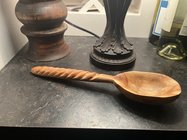I recently turned a spoon and power carved the end of it. I went ahead and sanded and oiled the spoon.
When I went to use it at home, the grain got fuzzy.
I didn’t some research and I saw two types of reasoning:
1) never sand a spoon only carve and won’t have issues when using (has anyone done this?…seems like something to do if you’re proficient in spoon carving)
Or
2) sand, raise the grain, sand again and oil and may have to repeat this over the life of it.
When I went to use it at home, the grain got fuzzy.
I didn’t some research and I saw two types of reasoning:
1) never sand a spoon only carve and won’t have issues when using (has anyone done this?…seems like something to do if you’re proficient in spoon carving)
Or
2) sand, raise the grain, sand again and oil and may have to repeat this over the life of it.

